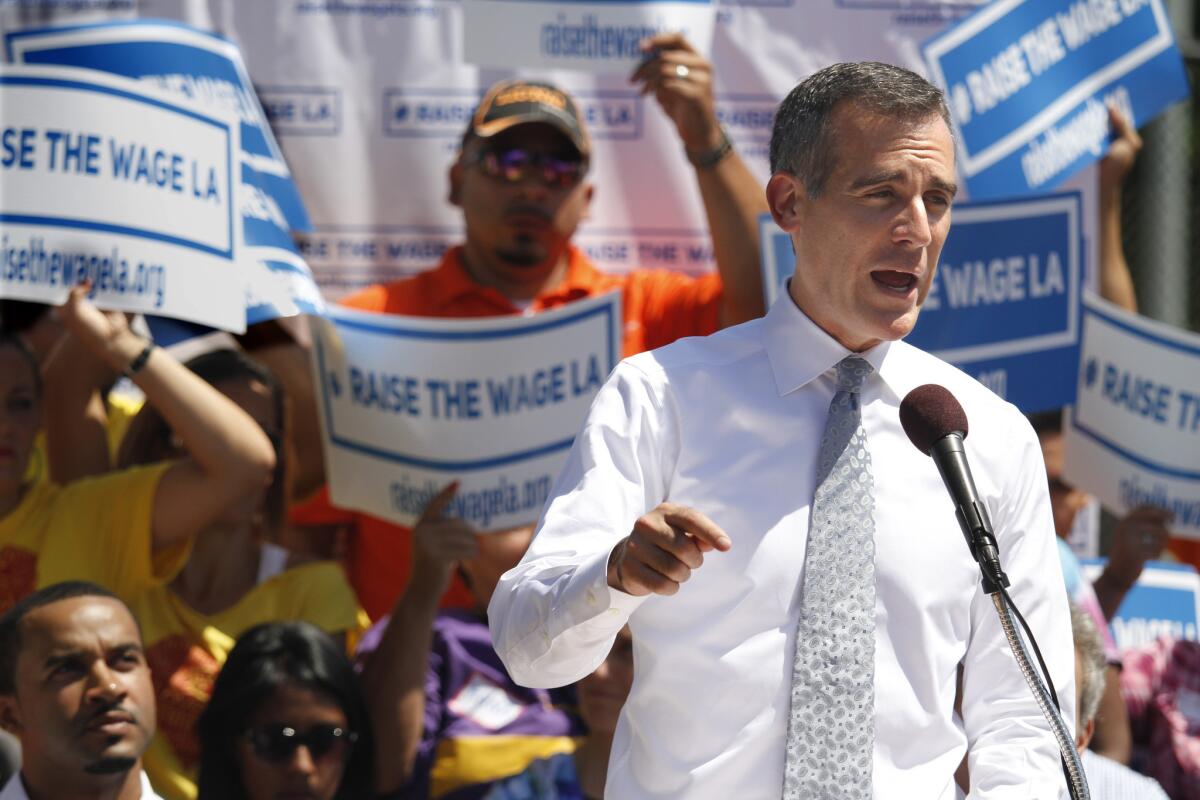Los Angeles joins the local movement to raise the minimum wage

Los Angeles Mayor Eric Garcetti marked Labor Day on Monday by proposing a minimum wage increase for workers in LA, to $13.25 an hour by 2017. The city would join a host of municipalities nationwide that have taken matters into their own hands in the face of resolute inaction by Congress.
It has long been obvious to all but the most conservative politicians and retrograde business lobbyists that this raise is long overdue. The billionaire investor and philanthropist Eli Broad has signed on, observing in a Labor Day op-ed in The Times that the increased wage “would be a great boost to our local economy. Workers would spend their higher wages on groceries, clothes and other basics for their families, putting the money right back into local businesses, which would, in turn, create jobs.”
By 2017, the affected workers would have a cumulative $1.8 billion more to spend. That’s according to a study Garcetti commissioned from the Institute for Research on Labor and Employment at UC Berkeley.
Garcetti’s proposal would raise the minimum in steps, starting at $10.25 next year and $11.75 in 2016. After 2017 the $13.25 wage would be indexed to inflation. It would keep a hop ahead of the state minimum wage, which is $9 now and will rise to $10 in 2016.
And it would be well ahead of the federal standard, which is mired at $7.25. That’s 25% below the minimum wage’s inflation-adjusted value in the 1960s; the proposal before Congress to raise the federal minimum to $10.10 still wouldn’t make those workers whole.
L.A. would join 14 other cities and counties that have raised their own minimum wages, many of them in the last year or two. Leading the movement is Seattle, which enacted a $15 minimum this year. In California, San Jose voters approved an inflation-linked increase in 2013 that currently sets the minimum at $10.15, and the San Diego City Council this summer approved an increase to $11.50 by 2017. Measures to raise the minimum to $12.25 in Oakland and $15 in San Francisco are on those city’s ballots for November.
Who are the workers and employers who would be most heavily affected by a Los Angeles wage raise? It’s not only workers who earn the minimum wage itself, for an increase at the floor tends to push other low-income wages higher.
While it’s tempting to dismiss minimum-wage workers as teenagers, the Berkeley study shows that isn’t so: only 3.2% of affected workers (including those benefiting from the ripple effect) are 18 or 19, while about 60% are between the ages of 20 and 39. About a third are married. Nearly two-thirds are Hispanic. Half earn twice the federal poverty level or less, and on average they bring in about half their family’s income. And more than two-thirds are full-time workers.
A total of 43% can be found in three industries -- restaurants, retail trade and healthcare. The Berkeley study forecasts that the most pronounced impact on prices will be found in the labor-intensive restaurant business, where prices might rise a total of 4.1% over the three years -- driving the price of a $10 meal, the study says, to $10.41. On the plus side, the higher minimum will cut down on worker turnover, which is a cost even in low-wage industries.
Will the higher minimum drive jobs out of the city? As we’ve reported before, decades of research have failed to establish a significant negative employment effect from the minimum wage -- and whatever effect exists is more than compensated for by improvements in overall income.
The Berkeley study takes heed of these impacts. It projects that restaurant employment growth in the city of L.A. might slow by 560 jobs, or 0.5% of annual employment in the sector -- but that would merely chip a bit from the 3.5% growth experienced during the year ended last February. And 77% of L.A. restaurant workers would be getting a raise.
A closer look is warranted for the garment industry. Berkeley acknowledges that garment manufacturing is labor intensive and already under pressure from foreign competition. The study says it can’t project how apparel firms will react to the higher minimum, but “cannot rule out” that some smaller firms might move to other locations in the county. Those that are closely tied to just-in-time demands from clients or to higher-end segments of the apparel trade are more likely to stay put.
It makes sense that communities in California and the West have taken the lead in raising the minimum wage. They’re high-cost communities, where the average dollar doesn’t go as far as it does in Midwestern locales such as Kansas and Missouri (see the accompanying map from the Tax Foundation). Although wages and prices tend to move roughly in tandem, the gap between the top and bottom tends to be wider in high wage -- and price -- regions.
To put it another way, minimum-wage workers fall farther behind the rest of the working class in purchasing power over time; that’s what justifies moving beyond the one-size-fits-all federal minimum.
Keep up to date with The Economy Hub by following @hiltzikm
More to Read
Inside the business of entertainment
The Wide Shot brings you news, analysis and insights on everything from streaming wars to production — and what it all means for the future.
You may occasionally receive promotional content from the Los Angeles Times.











